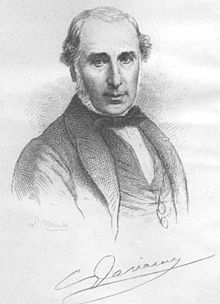Casimir Davaine
Casimir Davaine | |
|---|---|
 Casimir Davaine | |
| Born | 19 March 1812 |
| Died | 14 October 1882 (aged 70) |
| Nationality | French |
| Known for | Bacillus anthracis |
| Scientific career | |
| Fields | Microbiology |
Casimir-Joseph Davaine (19 March 1812 – 14 October 1882) was a French physician known for his work in the field of microbiology. He was a native of Saint-Amand-les-Eaux, department of Nord.
In 1850, Davaine along with French pathologist Pierre François Olive Rayer, discovered a certain microorganism in the blood of diseased and dying sheep.[1][2] In the diseased blood, Rayer and Davaine observed the bacillus that is known today as Bacillus anthracis, the causative bacterium of anthrax. Soon afterwards, Rayer published a description of the bacillus in a paper titled, Inoculation du sang de rate (1850).[3][4]
In 1863, Davaine demonstrated that the bacillus could be directly transmitted from one animal to another. He was able to identify the causative organism, but was unaware of its true etiology.[5][6] Later on, German microbiologist Robert Koch investigated the etiology of Bacillus anthracis, and discovered its ability to produce "resting spores" that could stay alive in the soil for a long period of time to serve as a future source of infection.[7]
Casimir Davaine is also credited for pioneer work in the study of sepsis (blood poisoning).[8]
References
- ^ Pierre François, Olive Rayer (1850). "Inoculation du sang de rate". Comptes Rendus des Séances et Mémoires de la Société de Biologie. 2: 141–144.
- ^ Swiderski, Richard M. (2014). Anthax: A History. McFarland. ISBN 9780786481965.
- ^ Heinrich Hermann Robert Koch - bibliography Who Named It
- ^ Biography of Pierre-François-Olive Rayer at Who Named It
- ^ Biographical Encyclopedia of Scientists, Third Edition edited by John Daintith
- ^ Bazin, Hervé (2011). Vaccination: a History - From Lady Montagu to Jenner Pasteur and Genetic Engineering (Médecine sciences). John Libbey Eurotext Ltd. p. 174. ISBN 978-2742007752.
- ^ Grove, David (2014). Tapeworms, Lice, and Prions: A compendium of unpleasant infections. Oxford University Press. ISBN 978-0199641024.
- ^ Klein, Edward (1886). Micro-organisms and Disease: An Introduction Into the Study of Specific Micro-organisms. Macmillan. p. 93.
Further reading
- Tomes, Nancy (1999). The Gospel of Germs: Men, Women, and the Microbe in American Life. Harvard University Press. ISBN 978-0674357082.
- Théodoridès, J (1994). "[Former observations of urinary bilharziasis and wuchereriosis]". Bulletin de la Société de pathologie exotique. 87 (3): 191–193. PMID 7827524.
- Rocchietta, S (January 1970). "[Casimir Joseph Davaine (1812–1882), pioneer of medical microbiology]". Minerva Med. 61 (6): XI. PMID 4904892.
- Théodoridès, J (April 1966). "Casimir Davaine (1812–1882): a precursor of Pasteur". Medical History. 10 (2): 155–165. doi:10.1017/S0025727300010942. PMC 1033586. PMID 5325873.
- Lagrange, E (February 1955). "[Casimir Davaine, pioneer in two fields.]". La Presse Médicale. 63 (12): 234–235. PMID 14371473.
